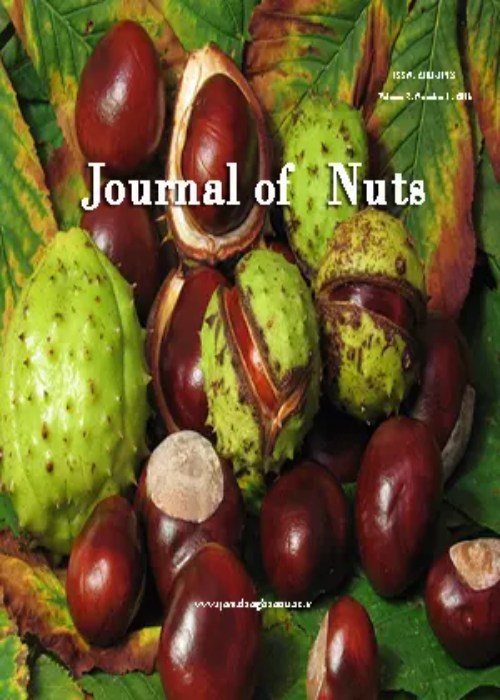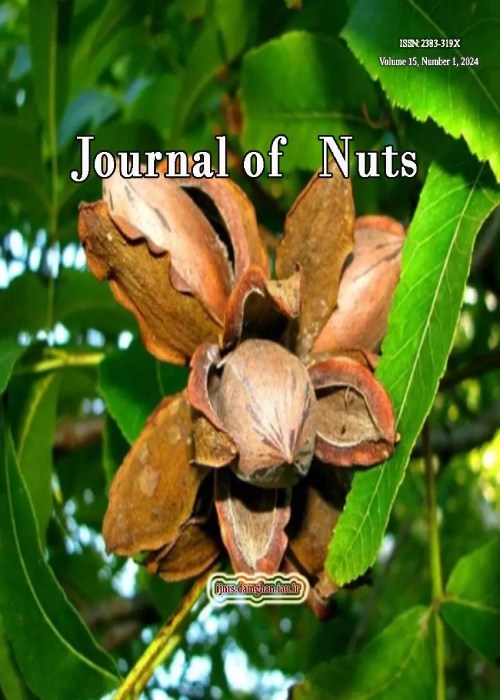فهرست مطالب

Journal of Nuts
Volume:14 Issue: 2, Spring 2023
- تاریخ انتشار: 1402/03/29
- تعداد عناوین: 6
-
-
Pages 95-111Although carbon dioxide (CO2) emissions are the most debated topic in the current era, the solution for this is not yet reached a conclusion in the literature. Further, curbing CO2 emissions along with maintaining the same pace of economic growth is necessary to achieve sustainable development. Being a top producing, processing and exporting country of cashew nuts in the world, India has a well-established growth effect that emanates from cashew nut production. However, the environmental effect of cashew nut production is not clear. Thus, this study aims to assess the role of cashew nut production on CO2 emissions while endogenising energy consumption and economic growth in the environmental degradation function of India during 1975-2021. For empirical analysis, the study uses combined cointegration, cointegrating regressions, and time and frequency domain causality tests. The evolved outcome shows a long-run cointegration of the series. Further, cashew nut production significantly reduces CO2 emissions, while energy consumption portrays a significantly increasing role in CO2 emissions. Surprisingly, but not shockingly, economic growth significantly reduces CO2 emissions in India. From the causality point of view, a unidirectional causality runs from cashew nut production to CO2 emissions in both time and frequency time causality tests. Based on the findings, the study suggests a policy for sustainable development in India.Keywords: Cashew nut production, CO2 emissions, Economic Growth, energy consumption, India, Time series
-
Pages 113-128Pelleting is a promising, cost-effective method to optimize the use of garden wastes as animal feed production. Shortage of animal feed and increasing costs are the main reasons to produce feed from garden wastes like green pistachio shell residues. In this study, green pistachio shell residues were gathered and stored in the open air to reduce moisture content, then the dried residues were hammered and sieved to make pellets using a hydraulic pellet maker machine. A factorial experiment with three factors was performed at temperatures of 50 and 65℃, moisture content levels of 15 and 20%, and compaction pressure with a single hydraulic pellet machine at 6000, 8000, and 11000 kPa using a 10 mm mold to investigate the possibility of pelleting green pistachio shell residues. Toughness and fracture energy are the important parameters for optimal pellet-making conditions. The produced pellets were investigated in terms of density, fracture energy, and toughness. The results showed that the effect of compaction pressure on the attributes was significant at the 1% level. The highest values of these attributes were obtained at the highest pressure of 11000 kPa. It was observed that the interaction effect of moisture and temperature on pellet density was the most significant level (1308.13 kg m-3) at temperatures of 65 ℃ and 15% moisture content. Also, the highest fracture energy and toughness (0.0228 J and 1.44×10-14 J m-3) were observed at temperatures of 50°C and 20% moisture content. Therefore, pellets made of green pistachio shell residues have sufficient density, fracture energy, and toughness, which makes pelleting a viable option for reducing transportation volume and costs in animal feed productionKeywords: Animal feed, Pellet quality, Pistachio waste, Transformational industries
-
Pages 129-140High genetic diversity is the guarantee of success in a breeding program. Therefore, it is important to study the genetic diversity in plant populations. Because Iran consider as one of the primary walnut origin centers, this study was conducted to evaluate the genetic diversity of the walnut population in the Bavanat region in the Southwestern Iran during the 2010-2015 growing season. For this purpose, 349 walnut seed-originated walnut trees from seven different regions of Bavanat were pre-selected based on local information. After primary evaluation, 92 walnut genotypes were selected to be further studied. The phenological and pomological characteristics of the genotypes were evaluated based on IPGRI descriptor. The results showed that high genetic diversity was observed in the studied germplasm in terms of important horticultural traits, especially nut and kernel weight, kernel percentage, nut size, shell thickness, lateral bearing, leafing date, and harvest date. The nut weight, kernel percentage, kernel weight, and shell thickness varied between 6.75-16.33 g, 40.15-67.22%, 3.30-8.15 g, and 0.58-2.30 mm, respectively. Cluster analysis classified the studied genotypes into six main groups. Furthermore, correlations among some horticultural traits indicated that kernel weight, nut weight, difficulty of removal of kernel halves, and shell thickness are main traits in determining kernel percentage. Also, lateral bearing, leafing date, nut weight, and nut size determine the final yield of walnut trees. In conclusion, high biodiversity in the walnut population of Bavanat region provides unique plant genetic resources for walnut genetic improvement programs to achieve desirable commercial cultivars and rootstocks.Keywords: Bavanat, Breeding program, Cluster analysis, Correlation, Walnut germplasm
-
Pages 141-150Type two diabetes is one of the most common endocrine diseases, and the lesser-known complication of diabetes is sexual dysfunction, which leads to, vaginal dryness in females and erectile problems in males. Therefore, it is necessary to study the influencing factors on the complication reduction of treatment. The main purpose of this present study was to examine the effects of 8 weeks of combined yoga exercises, almond consumption and diet on the sexual function of diabetic females in Damghan city. For this purpose, fifty diabetic women aged between 30 to 50 years old in Damghan were selected and matched based on their age, height, and weight into five groups (number in each groups=10 subject). The subjects randomly named 1.yoga exercises; 2. Almonds consumption; 3. Diet (doing all three items); and 4. Control group. Before and after the intervention period, blood pressure, blood sugar, waist, and hip size were measured and the subjects completed a dietary recall questionnaire. The first group subjects performed 10-minute breathing exercises, 20-minute stretching, and 15-minute concentration of yoga exercises in each session. The second group replaced 1 ounce (equivalent to 28.34 gr) of almonds with a 10% calorie intake per day. The third group implemented any of the diet programs set by the nutritionist, and the fourth group performed all of the above 3 conditions (yoga, almonds consumption & diet). The control group did not implement any of the above. TDEo analyses of the data, descriptive statistics and analysis of variance (ANOVA) were used. The results showed that eight weeks of yoga exercises, almond consumption, and diet significantly affect sexual function among diabetic women. However, no significant effect was observed on the sexual function after the intervention in the control group. Thus yoga exercises, almond consumption, and diet improved sexual function of diabetic women.Keywords: Almonds, Diabetes, Diet, Dietary Recall, sexual function, yoga
-
Pages 151-162This investigation aims to determine the nutritional value and physical traits of Syrian pine nut kernels and shells over time. Furthermore, the pine nut's composition and nutritional content are assessed concerning the latest climatic conditions. For each prepared sample, chemical analyses were done in two and physical analyses in three replicates, all according to a completely randomized design. The Homs District Agricultural Development Cooperative provided the pine nut shell samples used in this study. The sampling was conducted in May and June, taking subsamples of in-shell nuts from 25 kg bags. Every year, 15 subsamples were taken from various bags, and 33, 35, and 38 aggregate samples were generated. The in-shell nut quality showed seasonal variations concerning cracked and defective nuts, with crack rates spanning from 21 to 46% and 3 to 5%, respectively. The composition of the pine nut kernel was determined to have the following proportions: carbohydrates 12.19%, protein 32.18%, fat 43.2%, ash 4.93%, water activity 0.412, and moisture 4.31%. The elements with the greatest abundance were magnesium, phosphorus, and potassium. Additionally, kernels contain a high concentration of the minerals zinc and iron. The findings show that, compared to other Mediterranean pine nut sources, pine nut kernels cultivated in the Homs region are a rich source of several essential elements that positively impact public health.Keywords: chemical composition, fatty acid, Physical properties, Pinus species
-
Pages 163-171Pistachio butter is one of the pasty products made from pistachio kernels. This study investigated color characteristics, peroxide value, fat, protein, and carbohydrate content, and sensory evaluation of pistachio butter enriched with Spirulina algae (0, 5, and 10%) during three months of storage at 20°C. With increasing the percentage of the algae, the sample with 10% of the algae showed the highest protein content (around 25.4%). The highest and lowest fat content was observed in the control and the sample containing 10% algae, respectively. The lowest peroxide value (0.73 meq kg-1) was observed in the sample containing 10% algae compared to others. The level of carbohydrates did not change significantly in all three specimens during storage. Sensory evaluation for taste, sweetness, color, spreadability, mouthfeel, and texture showed that the sample without algae and the specimen containing 5% algae did not differ much. With increasing the algae level to 10%, the sensory evaluation had a significant drop, and in some cases, there was a decrease in the score. The color evaluation of the samples showed that with increasing the algae level, the greenness of the specimen increased, a value decreased, and b value did not show a significant change. Overall, The amount of algae recommended in the pistachio butter formulation is 5%.Keywords: enrichment, Nutrition, Oxidation, Pistachios, Sensory evaluation


